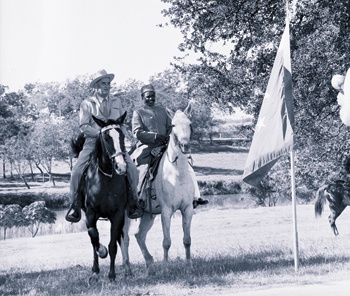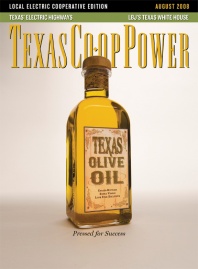The gnarled limbs of a giant live oak partially shroud the stately white ranch house and sprawling green lawn, offering passing motorists across the Pedernales River a glimpse, but nothing more. The setting’s serene, idyllic even … and off limits to the public.
That will change August 27 when festivities there mark the centennial of President Lyndon B. Johnson’s birth. For the first time, National Park Service staff will open part of Johnson’s lovely two-story home—once known as the Texas White House—for public tours at the LBJ Ranch near Stonewall. His restored office (circa 1968) will be the only room opened to the public; more will be opened as they become ready.
In 1951, Johnson, then a U.S. senator, and his wife, Lady Bird, bought the badly rundown home from relatives. Deep family ties anchored him there. He was born just down the road in a dogtrot farmhouse on August 27, 1908. At age 4, he’d run over to a one-room schoolhouse and sit in the teacher’s lap for reading lessons. Five years later, his family moved to Johnson City, where Johnson spent the rest of his childhood. Later in life, he fondly recalled the frequent trips his family made back to the Pedernales River, where an aunt and uncle hosted family celebrations at their grand home.
After extensive renovations, the Johnsons and their two young daughters, Lynda and Luci, moved into the ranch house in 1952. Johnson’s frenetic senatorial schedule soon took over. Activity at the ranch intensified when he became vice president in 1961. On some days, one vehicle after another wheeled in and out of the driveway. On a nearby airstrip, private jets landed and took off.
Thrust into the Oval Office in November 1963, Johnson ably took the reins and steered the nation through the dark days after President Kennedy’s assassination. In his new, high-stress role, Johnson flew home often to relax and work, too. In fact, logs indicate that Johnson lived there 490 days—about one-fourth of his five-year presidency. It wasn’t long before the press referred to the ranch as the Texas White House.
When home, Johnson ran the nation via telephones, radios and office staff. As many as 15 phone lines and 72 rotary phones serviced the house, other ranch buildings and numerous vehicles. Every room in the main house, including Johnson’s bathroom, had a telephone. Staff often joked that there “was a telephone behind every tree.”
With true Texas hospitality, Johnson hosted nearly 100 barbecues beneath the live oaks on the Pedernales during his presidency. International dignitaries, Cabinet members, national leaders and reporters, as well as neighbors and relatives, enjoyed the Western-style spreads, complete with red-checkered tablecloths, oil lanterns and plenty of beer.
A humble camel-cart driver from Pakistan ranks among the ranch’s more memorable visitors. While on a tour of Asia as vice president, Johnson extended an offhand invitation to Bashir Ahmed, who stood shirtless and shoeless in a crowd at a market. The next day, a Pakistani newspaper reported the invitation, much to Johnson’s surprise. In October 1961, sponsored by an international group, Ahmed put on shoes for the first time and flew to New York, where Johnson met him. At the LBJ Ranch, Ahmed—well-spoken though illiterate—toured the ranch via horseback. “Smoother than a camel,” he later said of the ride. Both countries pronounced Ahmed’s visit a resounding success. He even got a tour of Pedernales Electric Cooperative.
Every chance he got, Johnson drove guests around the ranch in his Lincoln Continental. With the top down, he’d cruise down bumpy caliche roads to see his cattle, sheep, pigpens, the family cemetery, his birthplace and the old schoolhouse. Sometimes, he used the time to politick and think. One eight-hour riding session in 1967 with Gov. John Connally and U.S. Rep. Jake Pickle ended with Johnson’s decision not to seek re-election.
Retired in 1969, Johnson spent his last years at the ranch. In December 1972, he and Lady Bird gave “our heart’s home” to the National Park Service but retained life estates for themselves. A month later, Johnson died. Lady Bird continued to live on the ranch and in Austin until her death in July 2007. Beneath the gnarled limbs of giant live oaks, both are buried in the Johnson Family Cemetery that overlooks the Pedernales River, not far from the Texas White House they both so loved.
——————–
LBJ National Historical Park, (830) 868-7128, www.nps.gov/lyjo. Bus tours of LBJ Ranch are available daily 10 a.m. to 4 p.m. Tour fees: 62 and older, $3; 18-61, $6; 7-17, $3; and 6 and under, free.
Sheryl Smith-Rodgers wrote about wildscape gardening in the March edition of Texas Co-op Power.


